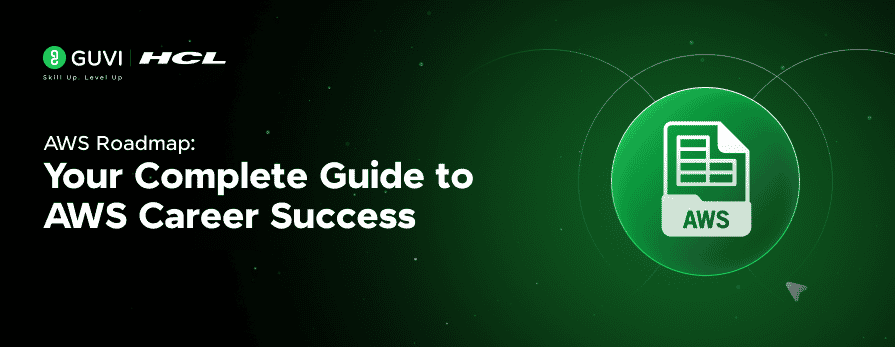
AWS Roadmap: Your Complete Guide to AWS Career Success
Aug 29, 2025 6 Min Read 1975 Views
(Last Updated)
AWS serves 1.45 million to over 4 million active customers across commerce, government, and research sectors, and those engagements demand professionals who steer cost‑efficient architectures with calm authority. When executives move core workloads into the cloud, they request proven hands who understand tenancy boundaries, latency budgets, and shared responsibility rules.
An organised AWS roadmap transforms a curious learner into that trusted voice. This guide explains ideas, then pairs them with labs so competence grows step by step and hiring managers see tangible evidence rather than vague enthusiasm. Each section builds on the last, so your momentum truly never stalls.
Continue reading this blog to align your study path with expectations.
Table of contents
- What is AWS?
- Brief History of AWS
- AWS Career Roadmap: Step‑by‑Step Guide
- Step 1: Understanding Cloud Basics
- Step 2: AWS Foundational Knowledge
- Step 3: Earning AWS Certifications
- Step 4: Gaining Real‑World Experience
- Step 5: Specializing in AWS
- Step 6: Landing an AWS Job
- Resources to Accelerate Your AWS Roadmap
- Best AWS Learning Resources
- Recommended AWS Books, Courses, and Tutorials
- AWS Roadmap Tools and Templates
- Common Mistakes and How to Avoid Them
- Why is AWS Important in Today’s Cloud Industry?
- Market Influence
- Ecosystem Depth
- Career Acceleration
- Community Support
- Benefits of Learning AWS
- Final Words
- FAQs
What is AWS?
Amazon Web Services is a utility model that offers compute, storage, and managed APIs through pay‑as‑you‑use billing. Engineers request virtual machines, object stores, and message queues with the console, SDKs, or Infrastructure as Code. The provider handles data‑center power and networking. Clients focus on application logic and quality signals while financial teams track spend in near real time.
Brief History of AWS
The platform grew from internal tooling that supported the Amazon retail store. In 2006, the company released Simple Queue Service and S3 to the public. Elastic Compute Cloud arrived in 2007 and turned server acquisition into a scriptable act.
In 2010, Amazon.com itself finished a full migration, which proved runway for other large enterprises. Lambda functions appeared in 2014, and Graviton processors followed in 2018. Each milestone widened the service catalog while keeping backward compatibility intact, a trait that protects long-running workloads.
AWS Career Roadmap: Step‑by‑Step Guide
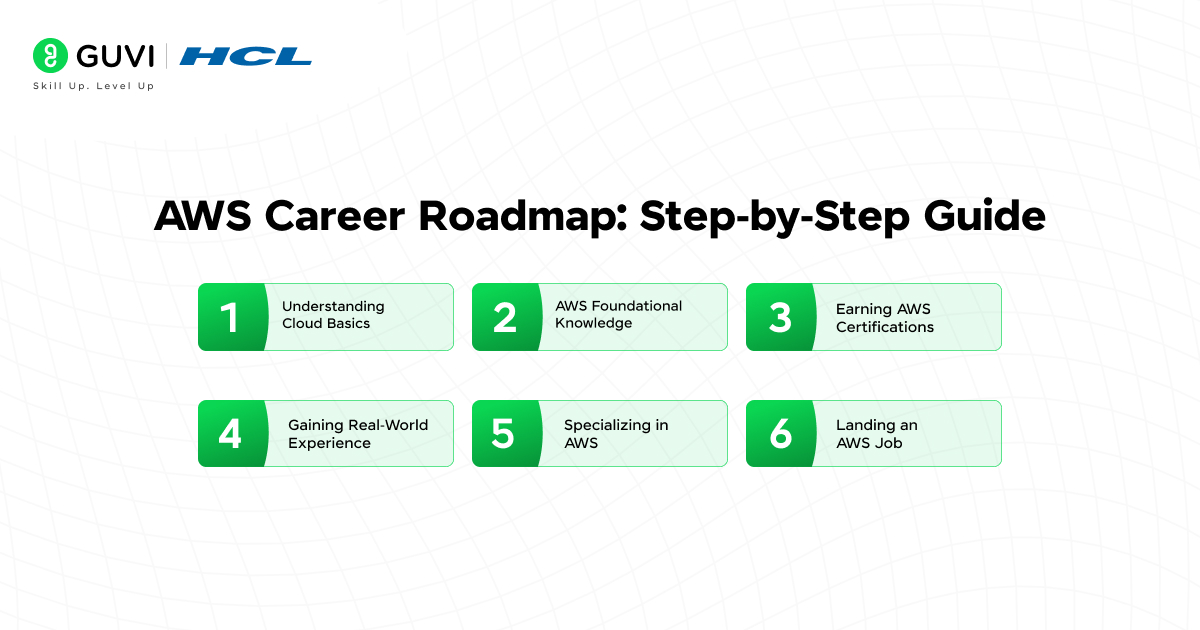
Here are the stages that help you, as a beginner, move toward professional execution with clarity and confidence.
Step 1: Understanding Cloud Basics
What is Cloud Computing?
To understand cloud computing, recognize that it involves using remote servers for computing and storage, accessed via the internet through APIs, rather than investing in physical hardware, allowing organizations to rent only the resources they need, control costs more effectively, and avoid lengthy setup times.
Foundational concepts include elasticity, which dynamically adjusts capacity to meet demand spikes; a pay-as-you-go model that aligns expenses with actual usage; and a shared responsibility framework that clearly defines security obligations between the provider and the tenant.
AWS vs Other Cloud Providers
It’s helpful to know why many choose AWS first. AWS offers a broader service range and more Regions compared to others. Azure works well with Windows systems, and Google Cloud is strong in analytics. Still, AWS remains a popular starting point because of better community support, more tutorials, and easier project replication.
Start your AWS journey with the GUVI AWS Course, a beginner-friendly program designed to help you master core services, build real projects, and earn certifications through hands-on learning and expert guidance.
Step 2: AWS Foundational Knowledge
Below are resources and core ideas that help you build real‑world understanding. Focus on regular practice to make learning stick.
- AWS Free Tier and Hands‑On Labs
Use the AWS Free Tier to try services without billing risk. It includes t2.micro compute and one million Lambda requests monthly. Guvi’s virtual labs also simulate AWS services to give a safe learning environment. Regular hands‑on use builds awareness that slides or lectures cannot provide.
- Core AWS Services to Learn First
EC2 introduces virtual machines. S3 helps you manage scalable file storage. IAM teaches how permissions work. CloudTrail shows who did what and when. These tools appear in nearly every AWS project, so gain comfort with each early on.
- AWS Shared Responsibility Model
AWS secures the data centers and network layers. You secure the configurations, data, and user permissions. Always ask yourself which part of the system you control and what AWS handles for you.
Step 3: Earning AWS Certifications
Below are certification paths and study tips. Certifications can signal readiness and commitment to employers reviewing your profile.
- Certification Levels
Start at the Foundational level, then progress through Associate, Professional, and Specialty levels. Each step builds on the last. Most learners begin with the AWS Certified Cloud Practitioner. It confirms your understanding of basic cloud principles and AWS services.
- AWS Certified Cloud Practitioner
This exam covers core topics such as billing, support, and security. Allocate twenty focused hours to studying, and include hands‑on tasks to make concepts stick.
- AWS Solutions Architect Associate
This exam measures how well you can design secure and cost‑efficient systems. Build labs with multi‑AZ databases and high-availability S3 hosting to reinforce learning.
- AWS Developer Associate
This badge focuses on event-driven applications and CI/CD pipelines. Expect to work with Lambda, API Gateway, and CodeBuild.
Accelerate your progress with the structured GUVI AWS course that combines expert-led lessons, real console labs, and clear certification paths tailored for beginners and career changers.
Step 4: Gaining Real‑World Experience
Hands‑on projects and open collaboration turn abstract concepts into reliable ability.
Here are practical routes to grow proven skill:
- Building Projects on AWS
Start small with a DynamoDB-backed contact form and add email notifications through SES. Then build a serverless image handler that stores thumbnails in S3. Keep your code in public repositories to show recruiters real work history.
- Contributing to Open Source AWS Projects
Find beginner-friendly GitHub repositories. Start by improving documentation or fixing small issues. Later, work on Lambda code or CloudFormation templates. Pull requests highlight both your technical thinking and your ability to collaborate.
Step 5: Specializing in AWS
Once the basics are in place, it’s time to focus. Specialisation helps you stand out and often leads to better compensation.
Following are common focus paths to consider:
- Advanced AWS Certifications
• DevOps Engineer Professional: Focuses on CI/CD, blue-green deployments, and automation at scale.
• Security Specialty: Emphasises secure architecture, encryption, incident response, and compliance.
• Data Analytics Specialty: Includes Glue, Athena, Redshift, and performance tuning for data workflows.
- Choosing Your AWS Career Path
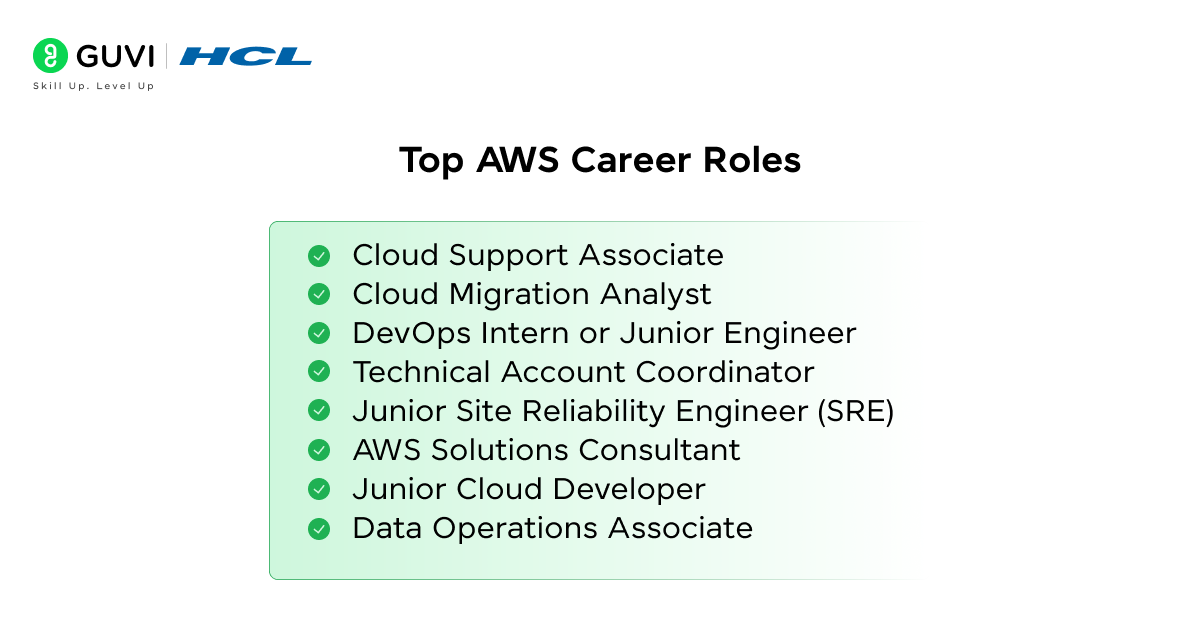
Here are diverse AWS-aligned roles you can pursue after building foundational skills:
• Cloud Support Associate in organisations that maintain internal AWS usage and need reliable hands to resolve console issues, permission requests or billing queries.
• Cloud Migration Analyst who helps teams move workloads from physical or legacy environments into AWS-managed services with minimal disruption.
• DevOps Intern or Junior Engineer assisting with automated build and deployment pipelines that improve release speed and rollback safety across teams.
• Technical Account Coordinator who manages AWS resource usage for external clients or across business units and optimises workloads with direct cloud service integrations.
• Junior Site Reliability Engineer (SRE) supporting uptime objectives by using CloudWatch metrics, alarms, and scripts to maintain platform health.
• AWS Solutions Consultant in pre-sales teams who guide clients through cost-optimised architectures using AWS calculators, service limits, and case studies.
• Junior Cloud Developer building event-driven functions, working with API Gateway and Lambda, and maintaining lightweight serverless backends.
• Data Operations Associate who ingests and processes files through AWS Glue jobs, runs queries using Athena, and prepares clean datasets for analysts.
Step 6: Landing an AWS Job
This is where preparation turns into opportunity.
Building an AWS‑Focused Resume
Use a clear format:
• Mention each certification with completion dates.
• List measurable outcomes from your projects.
• Include links to your repositories or portfolio.
Preparing for AWS Interviews
Expect questions around design, security, and cost planning. Practice IAM policy writing. Simulate availability scenarios on whiteboards. Review billing tools like Cost Explorer in depth.
Top Skills Employers Look for in AWS Professionals
• Understanding shared responsibility in real systems.
• Ability to write infrastructure as code using modern tools.
• Cost‑aware thinking that blends performance and efficiency
With this roadmap in place, you now have structure and direction. Stick to each step, stay consistent in your practice, and your efforts will translate into real-world results.
Resources to Accelerate Your AWS Roadmap
Following are learning aids grouped for different study styles.
Best AWS Learning Resources
- AWS whitepapers such as Well-Architected Framework
- Official workshops hosted on workshop.aws
- Re: Invent session recordings filtered by track and level
Recommended AWS Books, Courses, and Tutorials
- The AWS Certified Solutions Architect Official Study Guide is released after each syllabus update
- Cloud Engineering with AWS book that pairs theory with exercises
- Video walkthroughs on the YouTube AWS channel where engineers demo new features
- AWS Course by GUVI: You can learn AWS through hands-on labs and real-world projects
AWS Roadmap Tools and Templates
- Trello boards that track certification objectives and lab progress
- Markdown templates for architecture decision records
- Cost estimation sheets that compare on-demand and reserved rates
Common Mistakes and How to Avoid Them
Avoid these pitfalls so your AWS journey feels steady and rewarding.
• Skipping the fundamentals: Learn EC2 basics and S3 lifecycle rules before any specialty module. Practice with a micro instance each evening because small daily labs anchor concepts.
• Not building enough hands‑on labs: Watching videos produces recognition yet little recall. Set a weekly goal to deploy one service in the console, followed by the same task through CloudFormation.
• Neglecting soft skills: Architects must explain cost trade‑offs and security impact in plain language. Record short summaries of each project and share them with study partners for feedback.
• Ignoring cost visibility: Tags that capture environment and owner stop invoices from becoming mysteries. Review Cost Explorer every Friday and adjust idle resources before the weekend.
• Skipping identity boundaries: Broad IAM privileges feel faster during prototypes yet create audit pain later. Start every new project with a least‑privilege role template and extend permissions only after errors prove necessity.
• Overlooking network fundamentals: Misplaced route tables can stall traffic in ways that logs hide. Sketch a diagram of subnets and security groups before launching any multi‑tier stack.
• Delaying operational readiness reviews: Backup tests and incident drills reveal gaps while stakes remain low. Schedule a monthly game‑day where you simulate a single point failure and document the recovery steps.
Why is AWS Important in Today’s Cloud Industry?
AWS services control roughly one-third of global infrastructure revenue, and that share remains steady while new services climb. The platform spans nineteen Regions that connect through a private fiber backbone so data moves with consistent latency. Enterprises trust this reach because user requests land in nearby Availability Zones, which keeps response times predictable and user satisfaction high.
Students and organisations often begin with AWS because four practical qualities lower the barrier to entry and raise the ceiling for growth.
Market Influence
AWS stands as one of Amazon’s most profitable divisions, contributing over 115 billion U.S. dollars in net sales during 2024. Industry analysts project continued growth as more enterprises modernize their infrastructure and shift to cloud‑based operations. This long‑term stability gives learners confidence that investing time in AWS skills today will support career advancement well into the future.
Ecosystem Depth
Open‑source libraries, SaaS monitoring tools, and hardware partners publish AWS integrations before they support alternative clouds. That first‑mover culture means beginners find plug‑and‑play examples rather than writing custom adapters, which saves valuable study hours.
Career Acceleration
Job portals display more openings that request AWS expertise than listings for other providers. Salary surveys also present higher median pay for certified professionals. Hiring managers treat badges as evidence of structured learning, and they prefer candidates who already speak the platform’s terminology.
Community Support
Questions receive prompt answers on forums such as AWS re: Post and Stack Overflow. Local User Groups host monthly labs where attendees practise deployments in real time. Podcasts and newsletters supply constant updates so students stay aware of emerging features without expensive travel.
Benefits of Learning AWS
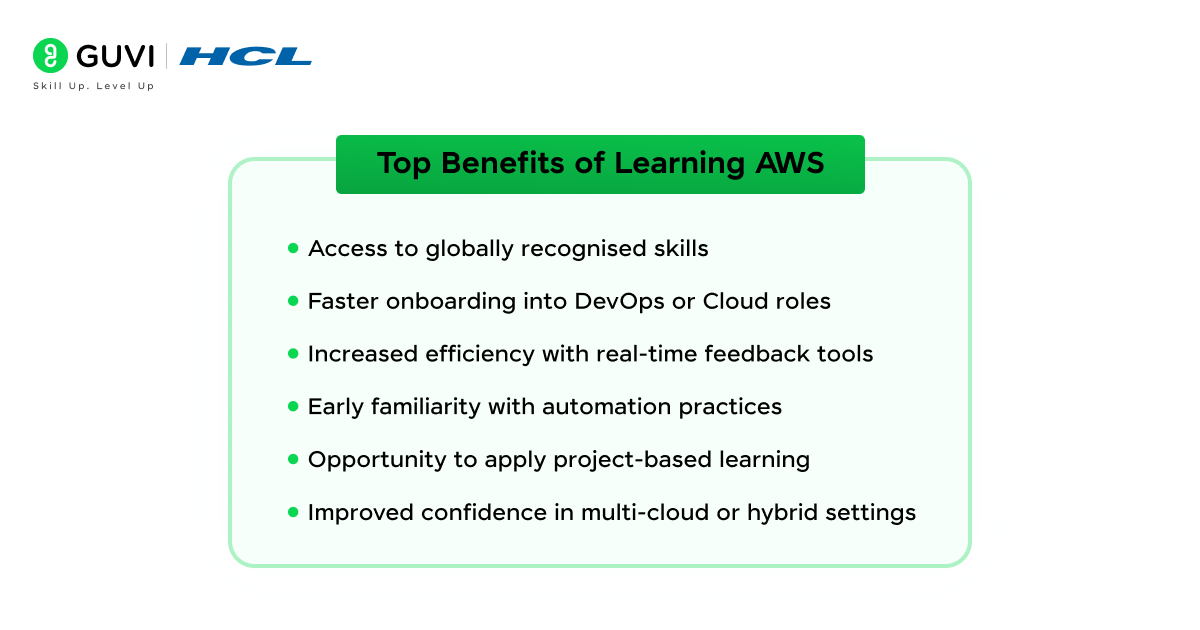
AWS opens a wide range of technical and career advantages, especially for students and early professionals building from the ground up. Beyond certifications and console familiarity, learners pick up a mindset that blends scalability, security, and automation into every solution they create.
Here are additional benefits that make AWS a valuable learning path:
• Access to globally recognised skills: AWS fluency applies across startups, enterprise teams, and public sector projects, which multiplies job options in both local and international markets.
• Faster onboarding into DevOps or Cloud roles: Employers expect new hires to understand versioned deployments, least-privilege access, and monitoring. These are standard habits taught early in the AWS learning curve.
• Increased efficiency with real-time feedback tools: Services like CloudWatch, X-Ray and Config show students how their applications behave, so improvements follow directly from observation, not guesswork.
• Early familiarity with automation practices: Concepts like Infrastructure as Code, continuous delivery, and serverless development enter your workflow naturally, long before reaching advanced stages.
• Opportunity to apply project-based learning: Every module in your AWS roadmap becomes a small working prototype, not just a theory note. That project-based format keeps interest alive and improves long-term retention.
• Improved confidence in multi-cloud or hybrid settings: Once foundational principles like VPC, IAM, and S3 become second nature, you’ll adapt faster when working with Azure or GCP later. AWS gives you that foundational clarity.
Final Words
Your journey now holds a clear sequence from cloud basics through portfolio projects and specialised certifications. Treat each stage as a sprint with a defined deliverable and celebrate progress since momentum drives retention.
Revisit goals every quarter and adjust based on project feedback or market trends. Keep learning logs, share insights with community peers and align study sessions with real workload demands. Above all, remain curious yet structured because that balance propels steady advancement and positions you for lasting success within the expanding AWS ecosystem.
FAQs
Q 1: How much daily study time should a beginner dedicate to AWS fundamentals?
Most beginners gain traction with ninety focused minutes each day. That pace keeps concepts fresh and prevents fatigue. Consistent honest practice builds muscle memory faster than weekend marathons.
Q 2: Is certification required to secure an entry‑level AWS role?
One associate badge often opens interview doors yet portfolio projects still clinch offers. Recruiters trust hands-on evidence that proves concepts translate into working systems.
Q 3: Which resources accelerate progress after earning the Solutions Architect Associate badge?
Pair official whitepapers with specialized Guvi AWS Course modules that focus on architecture labs. Regular community discussions reinforce ideas and expose emerging tools worth exploring next.
Q 4: What factors influence AWS billing for a small startup?
Pricing depends on four pillars. Compute hours and memory allocation from the base. Storage class choice adjusts cost as files age. Data transfer across Regions raises the bill when teams ignore locality. Sustained use forecasts allow reserved pricing that lowers monthly outlay.
Q 5: How does the AWS Well Architected Framework help new teams?
The framework supplies questions that expose weak design areas before launch day. Pillars cover reliability and performance so trade‑offs stay visible. Review sessions create documented action items that guide backlog tasks. Completed improvements raise confidence during external audits.
























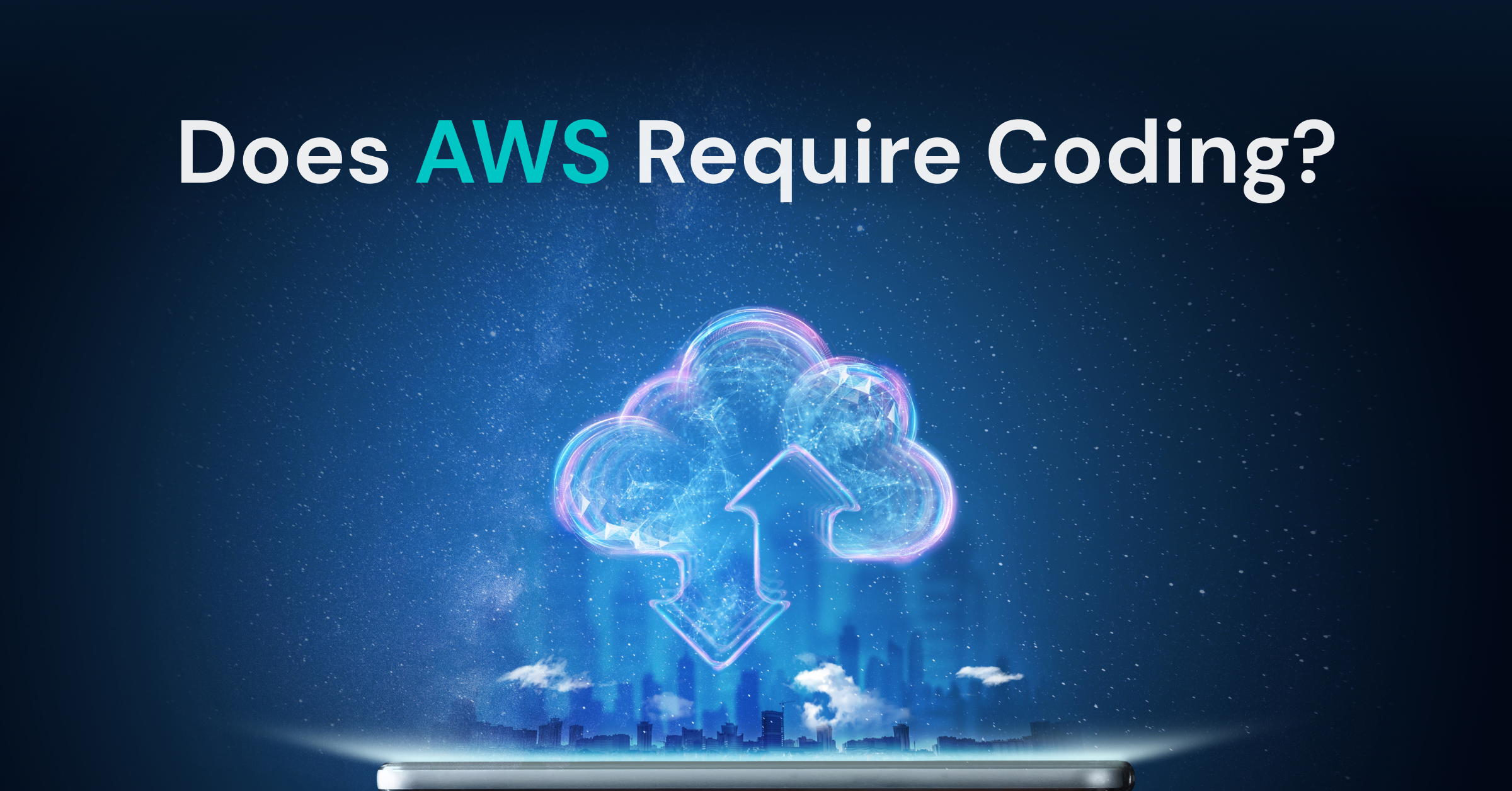

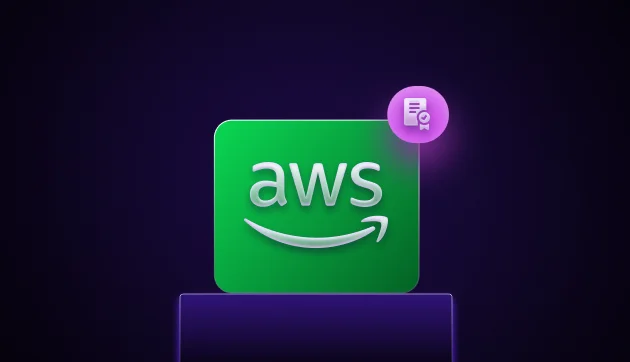
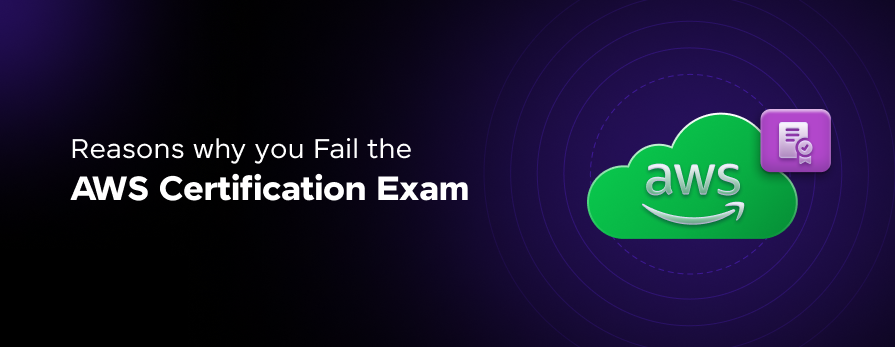
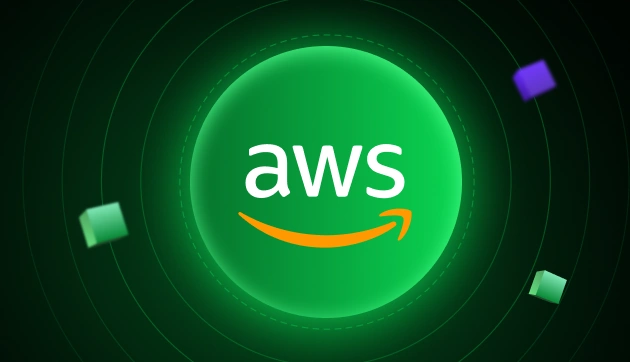
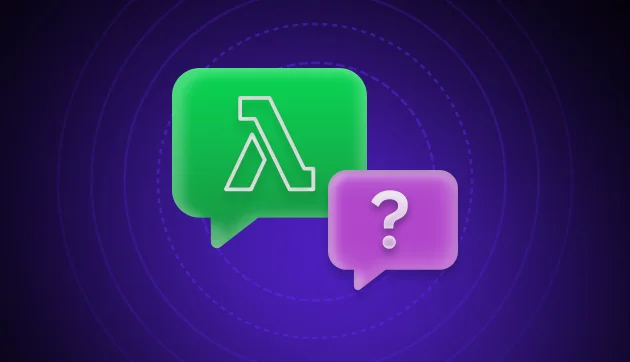
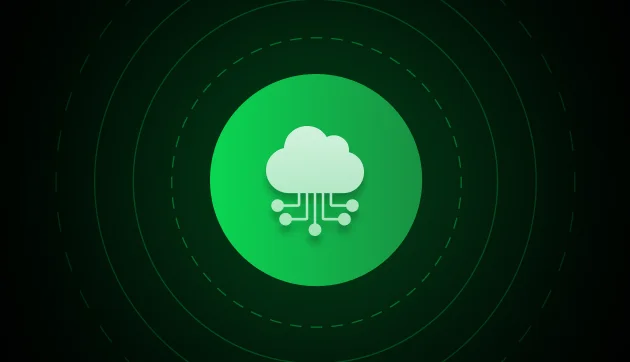





Did you enjoy this article?